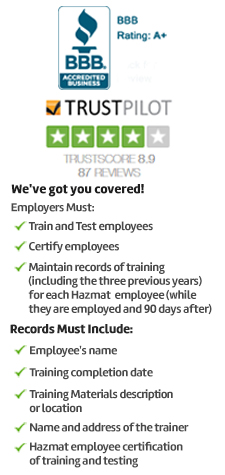__Inner_banner.jpg)
IMDG Shipping Training & Certification

This online training course will acquaint you both with the rules put forth by the IMDG Code and with the layout of the book itself. The IMDG Code book provides personnel involved in all aspects of maritime shipping with a single detailed reference for the procedures required to ensure safe packaging, carrying, and handling of hazardous materials and articles by sea.
Governing regulations
This International Maritime Dangerous Goods Regulations online course satisfies the training requirements of the IMDG Code with Amendment 38-16.
Persons taking this course and working on U.S. or foreign vessels operating in the navigable waters of the United States also need our DOT Hazardous Materials General/Security Awareness and Function
Course Overview
This course is designed to familiarize you with the most recent edition of the International Maritime Dangerous Goods Code (IMDG Code), incorporating Amendment 38-16. The IMDG Code is a two-volume resource that covers various provisions for the safe maritime transport of dangerous goods. This course will acquaint you both with the rules put forth by the IMDG Code and with the layout of the book itself. Upon completion of this course, you will be prepared in the basic use of the IMDG Code in the workplace.
Who Must Take this Course?
Persons required to take this training include; Shippers and forwarders, Container packers and consolidators, Shipping line operations and booking staff, Stevedores, Port staff and Cargo surveyors.
Course Format
Our International Maritime Dangerous Goods training course consists of content, graphics, audio, self check questions, and a final exam.
Continuing education credits?
Each student will receive 0.4 CEUs (or 4 CMEs) for completing this course.
Topics Covered
- About This Course
- Course Objectives
- Introduction to the IMDG Code
- IMDG Code Overview
- IMDG Code Contents
- IMDG Code Numbering
- IMDG Code Amendments
- About Amendment 38-16
- IMDG Code Part 1
- Introduction and General Provisions
- Definitions, Measurement, and Abbreviations
- Training of Shore-Based Personnel
- Security Risk Provisions
- General Provisions for Radioactive Material
- IMDG Code Part 2 – Classification
- Classification of Dangerous Goods
- The UN Number
- Multiple Hazard Classification
- Transport of Samples and Wastes
- Class 1-Explosives
- Class 1 Compatibility Groups and Classification Codes
- Class 1 Classification Procedures
- Class 2-Gases
- Class 2 Subdivisions and Mixtures of Gases
- Class 3-Flammable Liquids
- Packing Group Assignment
- Class 4-Flammable Solids
- Class 4.1-Flammable Solids, Self-Reactive Substances, and Solid Desensitized Explosives
- Class 4.2-Substances Liable to Spontaneous Combustion
- Class 4.3-Substances That Emit Flammable Gases When in Contact with Water
- Class 5-Oxidizing Substances and Organic Peroxides
- Class 5.1-Oxidizing Substances
- Class 5.2-Organic Peroxides
- Class 6-Toxic and Infectious Substances
- Class 6.1-Toxic Substance
- Class 6.2-Infectious substances: Definitions
- Categories of Infectious Substances
- Class 6.2 Exemptions
- Class 7-Radioactive Material
- Class 8-Corrosive Substances
- Class 8 Packing Groups
- Class 9-Miscellaneous Dangerous Substances and Articles and Environmentally Hazardous Substances
- Environmentally Hazardous Substances
- Lithium Batteries
- Marine Pollutants
- IMDG Code Part 3 – Introduction
- Proper Shipping Names
- Using the Dangerous Goods List
- Special Provisions for Certain Goods
- Limited and Excepted Quantities
- Appendix A, B, and Index
- Key Changes under Amendment 38-16
- IMDG Code Part 4 – Packing and Tank Provisions
- Packing Definitions
- Types of Containers
- General Provisions for Packing Dangerous Goods
- Overview of the List of Packing Instructions
- Using the List of Packing Instructions
- Special Packing Provisions for Goods of Various Classes
- Special Packing Provisions for Infectious Substances and Radioactive Material
- Use of Portable Tanks and Multiple-Element Gas Containers
- Portable Tank Instructions and Special Provisions
- Look-up of Portable Tank Instructions
- Bulk Container Codes
- Use of Bulk Containers
- IMDG Code Part 5 – Consignment Procedures
- Consignment Procedures
- Marking of Packages
- Labeling of Packages
- Placarding of Cargo Transport Units
- Marking of Cargo Transport Units
- Dangerous Goods Transport Documents
- Container/Vehicle Packing Certificate
- Other Documentation Required Aboard the Ship
- Special Provisions
- IMDG Code Part 6 – Construction and Testing of Packagings, Intermediate Bulk Containers, Large Packagings, Portable Tanks, Multiple-Element Gas Containers, and Road Tank Vehicles
- Provisions for the Construction and Testing of Packagings
- Code for Designating Types of Packages
- Marking
- Provisions by Packaging Type
- Documentation of Testing
- General Provisions
- Provisions for Packagings for Class 6.2-Category A
- Provisions for Packages and Radioactive Material
- Provisions for Intermediate Bulk Containers
- IBC Construction and Testing
- Provisions for Large Packagings
- Large Container Construction and Testing
- Bulk Container Provisions
- IMDG Code Part 7 – Provisions Concerning Transport Operations
- Stowage Provisions
- Segregation
- Consigning Operations for Cargo Transport Units
- CTUs, Special Situations
- Stowage and Segregation on Containerships
- Stowage and Segregation on Ro-Ro Ships
- Stowage and Segregation on General Cargo Ships
- Shipborne Barges on Barge-Carrying Ships
- Provisions for Shipborne Barge Cargo
- Special Requirements in the Event of an Incident and Fire Precautions Involving Dangerous Goods
- Responding to Incidents Involving Dangerous Goods
- Exemptions, Approvals, and Certificates
- What You Have Learned
- Exam

 NEBOSH CERTIFICATE
NEBOSH CERTIFICATE NEBOSH DIPLOMA
NEBOSH DIPLOMA IOSH
IOSH SAFETY DIPLOMA
SAFETY DIPLOMA CPD UK
CPD UK ROSPA UK
ROSPA UK FOOD SAFETY
FOOD SAFETY 



